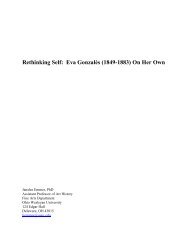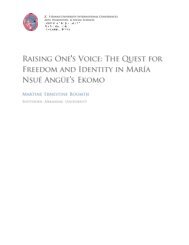2012 HUIC - Hawaii University International Conference on Arts and ...
2012 HUIC - Hawaii University International Conference on Arts and ...
2012 HUIC - Hawaii University International Conference on Arts and ...
You also want an ePaper? Increase the reach of your titles
YUMPU automatically turns print PDFs into web optimized ePapers that Google loves.
<str<strong>on</strong>g>2012</str<strong>on</strong>g> <str<strong>on</strong>g>HUIC</str<strong>on</strong>g> - <str<strong>on</strong>g>Hawaii</str<strong>on</strong>g> <str<strong>on</strong>g>University</str<strong>on</strong>g> <str<strong>on</strong>g>Internati<strong>on</strong>al</str<strong>on</strong>g> <str<strong>on</strong>g>C<strong>on</strong>ference</str<strong>on</strong>g> <strong>on</strong> <strong>Arts</strong> <strong>and</strong> Humanities<br />
January 8 - 10, <str<strong>on</strong>g>2012</str<strong>on</strong>g>, Ala Moana Hotel, H<strong>on</strong>olulu <str<strong>on</strong>g>Hawaii</str<strong>on</strong>g>, USA<br />
Exploring the Essence of Dance<br />
Darlene O'Cadiz<br />
Theatre <strong>and</strong> Dance Department at California State <str<strong>on</strong>g>University</str<strong>on</strong>g> Fullert<strong>on</strong><br />
P.O. Box 6850, Fullert<strong>on</strong>, CA 92834-6850<br />
docadiz@fullert<strong>on</strong>.edu<br />
The paper I am submitting is actually a porti<strong>on</strong> of the first chapter of the text book for my<br />
Dance <strong>and</strong> Cultural Diversity class at California State <str<strong>on</strong>g>University</str<strong>on</strong>g> Fullert<strong>on</strong> so<strong>on</strong> to be<br />
published by Cognella/<str<strong>on</strong>g>University</str<strong>on</strong>g> Reader in January <str<strong>on</strong>g>2012</str<strong>on</strong>g>.<br />
Abstract<br />
This paper explores the purpose of dance from the most rudimentary level<br />
referencing metaphor <strong>and</strong> justifying the study of dance as part of the quest to<br />
underst<strong>and</strong> humanity. Alan Lomax's c<strong>on</strong>tributi<strong>on</strong>s to preserving dance for<br />
anthropological study al<strong>on</strong>g with his theories presented in the documentary "Dance<br />
<strong>and</strong> Human History" is examined. The idea is presented that dance is a Universal<br />
language <strong>and</strong> has the capacity to communicate <strong>on</strong> a deeper level reflecting belief<br />
systems <strong>and</strong> social practices to genuinely express cultural attitudes.<br />
Darlene O'Cadiz<br />
California State <str<strong>on</strong>g>University</str<strong>on</strong>g> Fullert<strong>on</strong><br />
Theatre <strong>and</strong> Dance Department
Exploring the Essence of Dance<br />
Dance is a Metaphor for life. Dance seems to mimic not <strong>on</strong>ly natural human<br />
movements <strong>and</strong> experiences, but also complex natural processes. There have been many<br />
metaphors using dance as the reference. Scientists talk about the dance of particles <strong>and</strong><br />
organisms. The idea of something in c<strong>on</strong>stant moti<strong>on</strong>, cooperating, flowing rhythmically<br />
triggers <strong>on</strong>e to compare it with the idea of dance. As Santhanam Nagarajan states in his<br />
article Carl Sagan, Fritjof Capra <strong>on</strong> The Dance that Reveals the Mysteries of Universe?<br />
Part II " Physicists speak of the c<strong>on</strong>tinuous dance of sub-atomic matter which goes <strong>on</strong><br />
all the time. They have actually used the words dance of creati<strong>on</strong> <strong>and</strong> destructi<strong>on</strong> or<br />
energy dance. This naturally comes to mind when you see some of the pictures of<br />
particles taken by physicists in their bubble chambers." Writers also often describe ideas<br />
of life using the metaphor of dance. Nietzsche uses metaphors of dance to describe life<br />
<strong>and</strong> <strong>on</strong>es c<strong>on</strong>necti<strong>on</strong> to the earth yet a desire to dance with the gods <strong>and</strong> be <strong>on</strong>e with the<br />
art. He refers to "primal unity" surrendering will in the Di<strong>on</strong>ysian ecstasy dance of the<br />
reveler:<br />
In s<strong>on</strong>g <strong>and</strong> dance man expresses himself as a member of a higher<br />
community: he has forgotten how to walk <strong>and</strong> speak <strong>and</strong> is <strong>on</strong> the way<br />
toward flying into the air, dancing…he feels himself a god, he himself<br />
now walks about enchanted, in ecstasy, like the gods he saw walking in<br />
his dreams…He is no l<strong>on</strong>ger an artist, he has become a work of art: in<br />
these paroxysms of intoxicati<strong>on</strong> the artistic power of all nature reveals<br />
itself. (Nietzsche, Friderich (1871), The Birth of Tragedy) p.38<br />
Defining dance is like defining life to some people. A comm<strong>on</strong> B<strong>on</strong>tu greeting is "What<br />
do you dance?" meaning how do you express life? What is life about? Exploring different<br />
cultures <strong>and</strong> their dance styles sparks the pursuit to discover the human spirit <strong>and</strong> how<br />
people express life through movement. Witness the dance as it reflects belief systems <strong>and</strong><br />
societies structure in different cultures. Discover life <strong>and</strong> how to live it revealed in the<br />
dance.<br />
What is Dance?<br />
Before we can explore the history of dance, we must first define what dance is,<br />
<strong>and</strong> why humans do it. Most simply put, dance is movement to rhythm. The first instinct<br />
of a human being is to put his or her body in moti<strong>on</strong>. While still in the mother’s womb a<br />
baby listens to the rhythm of the mother’s heartbeat <strong>and</strong> has the urge to move. Before<br />
language is learned <strong>and</strong> developed, communicati<strong>on</strong> is revealed by means of movement<br />
<strong>and</strong> gestures. Movement is the most basic experience of life essential to human survival.
But even though dance is a form of moving, its functi<strong>on</strong> goes bey<strong>on</strong>d the simple<br />
movements humans rely <strong>on</strong> everyday. Dance is expressi<strong>on</strong>. Webster's dicti<strong>on</strong>ary defines<br />
dance as, “Moving rhythmically to music,” but it is so much more. Dance is a vehicle that<br />
has the power to unite mind, body, soul; it is a n<strong>on</strong>verbal means of communicating in the<br />
universal language, expressing abstract ideas <strong>and</strong> emoti<strong>on</strong>s by emitting an energy that can<br />
be recognized <strong>and</strong> felt by the affected observer. It has the power to transcend cultural<br />
boundaries <strong>and</strong> speak to people <strong>on</strong> a deep, spiritual level.<br />
The more subtle <strong>and</strong> complex comp<strong>on</strong>ents of dance are centering <strong>and</strong> breath.<br />
These highly emoti<strong>on</strong>al elements are what allow a dancer to be capable of authentic<br />
expressi<strong>on</strong>.<br />
Centering is related to the basic comp<strong>on</strong>ent of balance. In order to achieve a sense of<br />
balance, a dancer must engage the solar plexus <strong>and</strong> lower torso. This porti<strong>on</strong> of the body<br />
is where most of the body’s crucial organs are located. Focusing <strong>on</strong> this area gives a<br />
dancer a greater sense of strength <strong>and</strong> c<strong>on</strong>nectedness within his or her own body. This<br />
stability allows the dancer to bring forth a spiritual essence that can be displayed <strong>and</strong><br />
expressed with c<strong>on</strong>fidence. These deep feelings can be seen <strong>and</strong> felt by the audience.<br />
Dance is not the <strong>on</strong>ly practice that is aware of the power that comes from focusing <strong>on</strong><br />
<strong>on</strong>e’s center. Centering has also been used as a term in ancient philosophies <strong>and</strong> religious<br />
practices to define a pathway for realizing bliss <strong>and</strong> inner peace. Zen masters refer to it as<br />
a way to focus inward, while the Quakers used the term "centering down," to explain a<br />
state of focused attenti<strong>on</strong>, of attentive listening to <strong>on</strong>e’s inner voice. (Richards, 1989<br />
p.xx)<br />
Breathing <strong>and</strong> Breath are essential to all humans. Breath is life, we must breathe to live<br />
<strong>and</strong> move. More specifically, our muscles need oxygen in order to resp<strong>on</strong>d to the<br />
comm<strong>and</strong> of our brain. In dance, an awareness <strong>and</strong> c<strong>on</strong>trol over the breath allows the<br />
dancer to maintain a sense of rhythm. Most dances are synchr<strong>on</strong>ized to some form of<br />
music or sound. If the music is faster, the dancer must move faster <strong>and</strong> therefore breathe<br />
faster. If the music <strong>and</strong> dance is slow <strong>and</strong> el<strong>on</strong>gated, the dancer will be better able to<br />
perform if he or she focuses <strong>on</strong> taking deep <strong>and</strong> deliberately el<strong>on</strong>gated breaths. The<br />
dances of some cultures employ chanting, <strong>and</strong> these dances require <strong>and</strong> even deeper focus<br />
<strong>on</strong> the breathing patterns. But regardless of the type of dance, a dancer must be aware of<br />
breath to get oxygen to the part of the body producing the energy to move. It takes<br />
c<strong>on</strong>centrati<strong>on</strong> <strong>and</strong> practice to learn to breathe efficiently while moving, but <strong>on</strong>ce this<br />
element is mastered, a dancer is able to express a greater sense of grace <strong>and</strong> c<strong>on</strong>trol.<br />
The Essence <strong>and</strong> Origins of Dance<br />
When studying the history <strong>and</strong> development of dance, we must start at the beginning.<br />
Where <strong>and</strong> when did dance originate? The answer is simple: dance has existed for as l<strong>on</strong>g<br />
as mankind has. It is believed by many to be the first means of artistic expressi<strong>on</strong>,<br />
preceding even ancient forms of music <strong>and</strong> painting. In primitive societies, dance was<br />
both a social <strong>and</strong> ritualistic practice. Primitive men danced to celebrate every aspect of<br />
life. They danced to appease the Gods <strong>and</strong> give thanks to them, believing it would please
them <strong>and</strong> keep them from causing natural disasters <strong>and</strong> other forms of calamity. They<br />
also danced to express emoti<strong>on</strong> <strong>and</strong> to underst<strong>and</strong> their relati<strong>on</strong>ship with nature.<br />
Many early peoples believed that when they danced with a particular energy <strong>and</strong> rhythm,<br />
they could bring about a desired effect. For example, some cultures believed that a wellexecuted<br />
rain dance could bring rain. Rhythmic movement was seen as <strong>on</strong>e way to<br />
communicate with the Gods. Early man had many elements to deal with, including<br />
natural catastrophes. Without the aid of modern science, these events often seemed<br />
r<strong>and</strong>om <strong>and</strong> inexplicable. They attributed these events to the will of the spirit world.<br />
Often the meditative collaborati<strong>on</strong> of tribal musicians <strong>and</strong> dancers would send the<br />
performers into what was thought to be an altered c<strong>on</strong>sciousness. This was believed to be<br />
a sign of divine presence. In this state of being, the participants often claimed to<br />
commune with the spirit world, <strong>and</strong> receive messages <strong>and</strong> instructi<strong>on</strong>s for how to survive.<br />
While to the modern viewpoint, these ideas may seem illogical, ritualistic practices, such<br />
as dance, were <strong>on</strong>e way that ancient peoples could explain or cope with forces bey<strong>on</strong>d<br />
their c<strong>on</strong>trol. They danced with the hope that it could influence the decisi<strong>on</strong>s of the Gods.<br />
And when a desired result followed their dance, such as a heavy rainfall following a rain<br />
dance, it gave people a sense that they had some impact <strong>on</strong> their situati<strong>on</strong>s. It made them<br />
feel intuitive <strong>and</strong> powerful.<br />
In fact, some of the earliest rock paintings show dancers, indicating that it was a wellestablished<br />
part of primitive existence. For example, Archeologists have discovered<br />
prehistoric rock paintings from the Paleolithic era (circa 17,500 BC) in Lascaux, France<br />
that depict dancing figures. Many other primitive drawings <strong>and</strong> paintings found in caves<br />
<strong>and</strong> burial tombs around the world attest to the fact that dance was a major part of<br />
expressing life.<br />
The well-known dance critic, John Martin discusses the significance of dance in ancient<br />
cultures:<br />
"If we go back to the earliest times, we find that primitive men danced<br />
when they were deeply moved…Whenever the primitive mind came<br />
into c<strong>on</strong>tact with something that happened without his having anything<br />
to do with it, something with the element of mystery <strong>and</strong> supernaturalism,<br />
he danced" (Martin, 1989 p.8-9)<br />
Dance has survived as a means of communicati<strong>on</strong> <strong>and</strong> a way of preserving traditi<strong>on</strong>s in<br />
different communities in different cultures. The ritual of dance c<strong>on</strong>nects the dancer to a<br />
supreme force outside of <strong>on</strong>eself. Social dance c<strong>on</strong>nects the dancer to the tribe <strong>and</strong> others<br />
in the community. The art of dance brings self-awareness to the dancer <strong>and</strong> their audience<br />
through storytelling <strong>and</strong> expressi<strong>on</strong> of emoti<strong>on</strong>.<br />
Explanati<strong>on</strong> of Alan Lomax's study of Dance in Human History
Since dance is the most repetitious, synchr<strong>on</strong>ic of all expressive behaviors, it has turned<br />
out to be a kind of touchst<strong>on</strong>e for human adaptati<strong>on</strong>. Alan Lomax, 1975<br />
Alan Lomax was an anthropologist interested in analyzing dance from different cultures,<br />
<strong>and</strong> identifying communicati<strong>on</strong> that occurred <strong>on</strong> a kinetic <strong>and</strong> subc<strong>on</strong>scious level. He<br />
searched relentlessly for footage of dance from around the world particularly, in remote<br />
locati<strong>on</strong>s. In his article, "Toward an Ethnographic Film Archive" Lomax expresses his<br />
c<strong>on</strong>cern about the changing world <strong>and</strong> the threat this had to primitive cultures. He<br />
believed that the negative bi-product of scientific progress <strong>and</strong> modernizati<strong>on</strong> was that it<br />
could cause these cultures to lose their traditi<strong>on</strong>s, rituals, <strong>and</strong> art. Dance in particular, was<br />
in extreme danger. Unlike a painting or sculpture, which can be preserved in its original<br />
form or reproduced in photographs, dance is an ephemeral art, <strong>and</strong> can <strong>on</strong>ly be<br />
understood by experiencing or observing it. Written descripti<strong>on</strong>s can <strong>on</strong>ly hint at the<br />
message the actual kinetic movement displays. Thus, Lomax felt it crucial that cultural<br />
dances be documented not through static media such as photography or written<br />
descripti<strong>on</strong>s, but through film. His film, Dance in Human History, produced in 1976,<br />
makes use of the footage he collected to dem<strong>on</strong>strate his theory of movement defining<br />
cultural traditi<strong>on</strong>s.<br />
At the American Anthropological Associati<strong>on</strong> meeting held in San Diego in the<br />
fall of 1970, Lomax presented his reas<strong>on</strong>s for preserving original dances <strong>on</strong> film. This<br />
presentati<strong>on</strong> was m<strong>on</strong>umental in the field of dance history, <strong>and</strong> as a direct result,<br />
anthropologist Margaret Mead was elected the president of the Anthropological Film<br />
Research Institute. Her work led to the establishment of The Ethnographic Film Archive<br />
in the Smiths<strong>on</strong>ian Institute in Washingt<strong>on</strong>, D.C. (Lomax, 1971). Alan Lomax <strong>and</strong><br />
Margaret Mead <strong>and</strong> other leading anthropologists dedicated themselves to filming <strong>and</strong><br />
archiving films of indigenous dances to help preserve the study of cultural traditi<strong>on</strong>s. The<br />
work of Lomax <strong>and</strong> Mead, al<strong>on</strong>g with John Wesley Powell led to the establishment of the<br />
Nati<strong>on</strong>al Anthropological Archives in 1979.<br />
Alan Lomax created the term Choreometrics to describe his study of dance as a form of<br />
expressive behavior. He took advantage of the film archive <strong>and</strong> analyzed dance styles<br />
from around the world, classifying them by the type of repetitive movements found in<br />
each culture’s dances. One of his most groundbreaking discoveries was a correlati<strong>on</strong><br />
between the type of dance movement a culture participated in, <strong>and</strong> that culture’s<br />
ec<strong>on</strong>omic status <strong>and</strong> st<strong>and</strong>ing. He described movement types in terms of dimensi<strong>on</strong>s. The<br />
most basic dance dimensi<strong>on</strong> is <strong>on</strong>e-dimensi<strong>on</strong>al style. It c<strong>on</strong>sists of linear (straight up<br />
<strong>and</strong> down) movements, which reflected the kind of work movements some<strong>on</strong>e uses when<br />
working with st<strong>on</strong>e or wood. He determined that 70% of simple ec<strong>on</strong>omies employ a<br />
<strong>on</strong>e-dimensi<strong>on</strong>al movement style. For example, people working with st<strong>on</strong>e or wood must<br />
apply careful straight strokes in order to carve into these hard <strong>and</strong> brittle mediums, <strong>and</strong><br />
also to skin animals for food <strong>and</strong> pelts clothing. Meanwhile, the two-dimensi<strong>on</strong>al style<br />
uses curved or circular movements. 80% of the ec<strong>on</strong>omies that used metal tools like<br />
sickles, which require a semicircular slashing moti<strong>on</strong> to cut wheat or other materials, also
used that kind of moti<strong>on</strong> in their dance. Examples of this two-dimensi<strong>on</strong>al style can be<br />
seen in many dances that originated in Africa, <strong>and</strong> also in some European dances, such as<br />
the Spanish Jota. Finally, three-dimensi<strong>on</strong>al movement styles use a spiral moti<strong>on</strong>,<br />
which mimics water wheels used in Asia <strong>and</strong> Europe for agricultural irrigati<strong>on</strong>. 80% of<br />
these more sophisticated ec<strong>on</strong>omies use the full body spin in their dance styles. The<br />
correlati<strong>on</strong> between the moti<strong>on</strong> of a culture’s daily tasks <strong>and</strong> the type of moti<strong>on</strong>s found in<br />
that culture’s dances suggest that these dances were meant to express or record specific<br />
aspects of their civilizati<strong>on</strong>s. On the other h<strong>and</strong>, if these correlati<strong>on</strong>s were not c<strong>on</strong>scious,<br />
Lomax’s theory is supported by what we know about human muscle memory, which<br />
naturally lends itself to any repetitive bodily moti<strong>on</strong>. Even when these cultures used<br />
movement as a means of release <strong>and</strong> recreati<strong>on</strong>, they tended to move in the same way as<br />
they did when working.<br />
In additi<strong>on</strong> to his classificati<strong>on</strong> of dimensi<strong>on</strong>al movement, Lomax also defined single<br />
unit <strong>and</strong> multi-unit movement styles. The single unit style uses a solid torso, mostly<br />
moving the legs, feet <strong>and</strong> arms <strong>and</strong> sometimes bending or using a rhythmic rocking<br />
moti<strong>on</strong> forward <strong>and</strong> back a the waist. 85% of the cultures that displayed this kind of<br />
dance were from patriarchal hunting cultures. They also tended to exist in cultures from<br />
colder climates. Meanwhile, multi-unit styles use an articulate torso, in which there is<br />
movement in the hips <strong>and</strong> undulati<strong>on</strong> in the ribcage. 90% of cultures displaying multiunit<br />
styles of dance are from matriarchal <strong>and</strong> agricultural societies. These styles are found<br />
in warmer <strong>and</strong> often tropical climates. One explanati<strong>on</strong> for the difference styles of dances<br />
found in patriarchal <strong>and</strong> matriarchal societies is that in matriarchal <strong>and</strong> agricultural<br />
societies, there is a greater value of fertility. The hip rocking moti<strong>on</strong>s found in these<br />
cultures are representative of sexual moti<strong>on</strong>, <strong>and</strong> can be seen as a way to prepare a pers<strong>on</strong><br />
for sexual activity.<br />
The purpose of Dance<br />
While modern science informs us that human rituals do not affect envir<strong>on</strong>mental forces,<br />
that rain dances do not in fact, cause rain, dance is still an effective means of<br />
communicati<strong>on</strong> <strong>and</strong> a way of preserving traditi<strong>on</strong>s in different communities <strong>and</strong> cultures.<br />
The ritual of dance has the power to c<strong>on</strong>nect. Primitive people danced in h<strong>on</strong>or <strong>and</strong><br />
celebrati<strong>on</strong> of every aspect of life. There were dances to give thanks <strong>and</strong> h<strong>on</strong>or the gods<br />
<strong>and</strong> ancestors al<strong>on</strong>g with dances to cast out evil spirits. There were dances to celebrate<br />
the rites of passage like birth, puberty, marriage <strong>and</strong> death. There were dances to prepare<br />
for the hunt <strong>and</strong> war. Some dances were used to tell stories <strong>and</strong> pass <strong>on</strong> tribal traditi<strong>on</strong>s.<br />
A str<strong>on</strong>g <strong>and</strong> mobile body was vital to survival in prehistoric times <strong>and</strong> dancing helped to<br />
keep the people str<strong>on</strong>g. Ritual dances <strong>and</strong> social dances were a way of life.<br />
In our society today we still celebrate certain aspects of life with dance. Children<br />
naturally dance to music as they express happiness. Teenagers <strong>and</strong> young adults go to<br />
school dances or clubs to dance <strong>and</strong> socialize. There are coming of age dances that are<br />
still celebrated. In the Hispanic community the Quinceanera or girls 15th birthday is a<br />
celebrati<strong>on</strong> were dance is a comp<strong>on</strong>ent. Also at the Bar Mitzvah a Jewish coming of age<br />
celebrati<strong>on</strong> for boys turning 13 a circle dance called the Hora is performed al<strong>on</strong>g with
some social dancing. Dancing is also a part of a wedding celebrati<strong>on</strong>. The Bride <strong>and</strong><br />
Groom do a first dance <strong>and</strong> their parents cut in to have <strong>on</strong>e last dance then all the guests<br />
join in to celebrate.<br />
Cultural attitudes are reflected in the dance. While watching a dance from another<br />
country where you d<strong>on</strong>'t know the language <strong>on</strong>e can somehow interpret the basic idea.<br />
This is because movements expressing emoti<strong>on</strong>s transcend language. As part of the<br />
human race we all seem to feel <strong>and</strong> underst<strong>and</strong> the same emoti<strong>on</strong>s. All human beings<br />
experience joy, sorrow, h<strong>on</strong>or, fear, gratitude, love, empathy, anger, disappointment, <strong>and</strong><br />
a multitude of emoti<strong>on</strong>s that are expressed in body movements <strong>and</strong> gestures al<strong>on</strong>g with<br />
the minds intenti<strong>on</strong>s that can be recognized by the sensitive observer. Because of the<br />
awareness of different cultures <strong>and</strong> blending of different cultures around the world, dance<br />
styles from different cultures are blending too.<br />
Dance can express feelings <strong>and</strong> emoti<strong>on</strong>s but can it also heal the spirit or even the world?<br />
In the popular reality TV show "Dancing with the Stars" Steven Guttenburg <strong>on</strong>e of the<br />
c<strong>on</strong>testants in seas<strong>on</strong> 6 made the comment that dancing with a partner requires a level of<br />
cooperati<strong>on</strong> <strong>and</strong> communicati<strong>on</strong> that is highly sophisticated <strong>and</strong> if the world leaders<br />
would learn the cooperati<strong>on</strong> <strong>and</strong> coordinati<strong>on</strong> of dancing the world would be a better<br />
place.<br />
It is important to study dance history to c<strong>on</strong>template <strong>and</strong> gain underst<strong>and</strong>ing of the<br />
rhythms of life, to realize its universal communicati<strong>on</strong> possibilities, <strong>and</strong> to better<br />
underst<strong>and</strong> cultural differences <strong>and</strong> similarities as a means of broadening our awareness<br />
of humanity.<br />
Bibliography<br />
Lomax, A. (1971), Toward an ethnographic film archive. Filmmakers Newsletter,<br />
February Vol 4 #4 p. 1-12, retrieved from John Bishop December 1999,<br />
www.cda.ucla.edu<br />
Martin, J. (1989). The modern dance. Princet<strong>on</strong>, NJ: Dance Horiz<strong>on</strong> Books.
Nagarajan, S. (2009). Carle Sagan, Fritjof Capra <strong>on</strong> "The danc that reveals the Myteries<br />
of Universe" ? Part II. Article haul.com retrived from http://www.articlehaul.com/selfhelp/article553.htm<br />
Nietzsche, F. W. (2000). The birth of tragedy. New York:Oxford <str<strong>on</strong>g>University</str<strong>on</strong>g> Press<br />
(eBook).<br />
Richards, M.C. (1989). Centering: In pottery, poetry <strong>and</strong> the pers<strong>on</strong>. Wesleyan <str<strong>on</strong>g>University</str<strong>on</strong>g><br />
Press: Middletown C<strong>on</strong>necticut.<br />
Discussi<strong>on</strong> Questi<strong>on</strong>s<br />
Discuss each questi<strong>on</strong> <strong>and</strong> give examples to explain your c<strong>on</strong>clusi<strong>on</strong>. If you use outside<br />
sources please make reference to them <strong>and</strong> include the citati<strong>on</strong> in your written work.<br />
1. Why do human beings believe there is a force outside of themselves that c<strong>on</strong>trols life?<br />
a. Can you prove that there is?<br />
b. Why is the belief so str<strong>on</strong>g?<br />
c. Will humans always believe there is a superior being or force?<br />
2. In the 1970's Alan Lomax expressed his c<strong>on</strong>cern about the rapidly changing world <strong>and</strong><br />
the need to document traditi<strong>on</strong>al dances. How has the world changed since then?<br />
a. Do you think that most people around the world are aware of different cultures?<br />
b. What has c<strong>on</strong>tributed to the changing world?<br />
c. Has technology c<strong>on</strong>tributed to global awareness? How?<br />
3. Dance is thought to be a universal language. Why?<br />
a. Are there other ways to communicate transcending the language barrier?<br />
b. What needs to all humans from every culture have in comm<strong>on</strong>?<br />
c. What makes each culture unique?<br />
4. What kind of dances represents your generati<strong>on</strong>?<br />
a. How does this dance express the attitudes of your culture?<br />
b. Can you find a link to a culture other than American culture? Is there history?<br />
c. How does it compare to your parents generati<strong>on</strong>?







